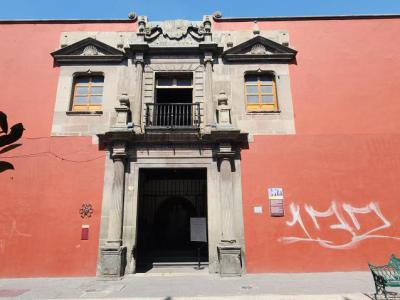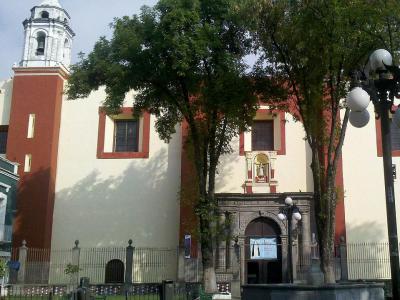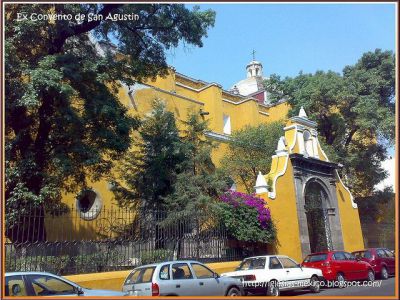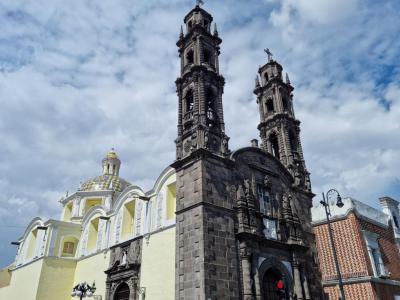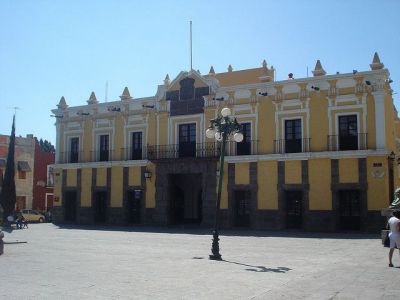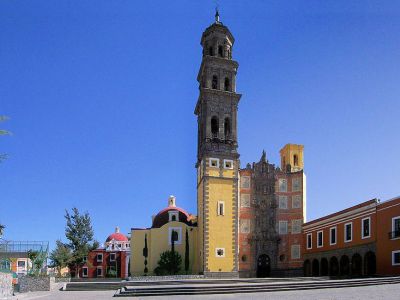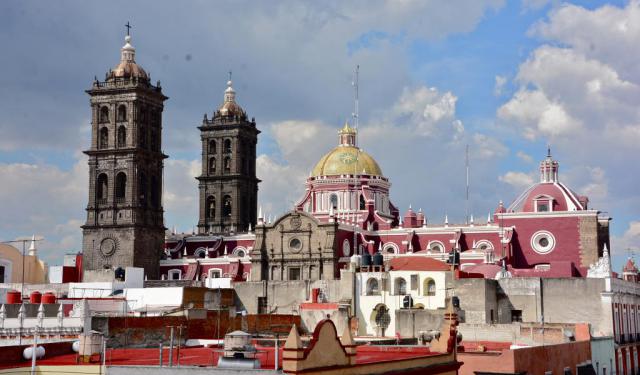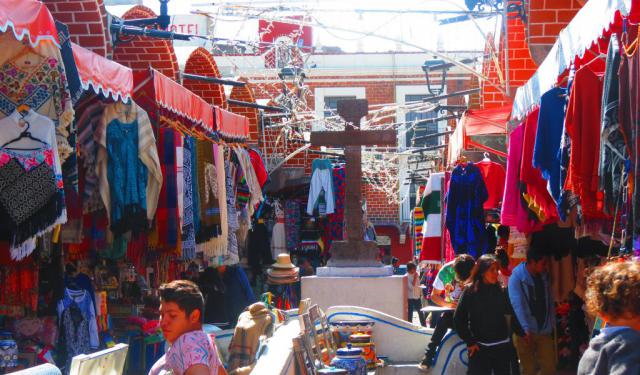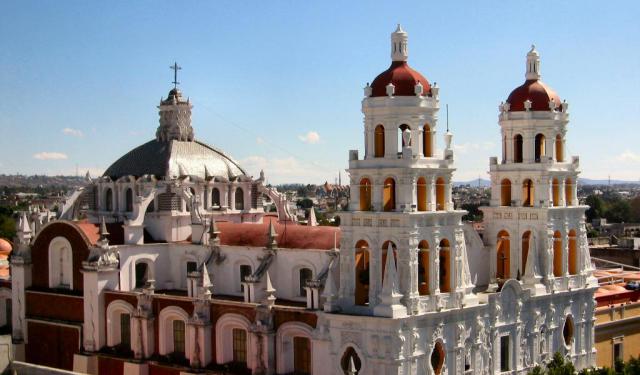
Puebla Colonial Architecture Walking Tour (Self Guided), Puebla
One of the most authentic and traditional destinations in Mexico, the city of Puebla abounds in Baroque architecture, or rather the peculiar regional form thereof resulted from the fusion of European and indigenous styles in the 17th and 18th centuries.
Visiting this magical place you will find lots of (more than 70!) sumptuous churches, convents and sanctuaries, as well as other incredible buildings whose cupolas and walls are clad in gaily colored tiles (azulejos), ensuring the unity of the architectural landscape. The city’s main attractions are located in the gorgeous historic downtown area whose rectangular urban design had exerted a considerable influence on the development of other colonial cities throughout Mexico and further afield in the New World.
The historic center of Puebla has preserved its integrity primarily through the retention and extension of the original Renaissance grid plan laid out in the mid-16th century. Many buildings from that period, including major religious sites like the imposing (over 207 feet high) Cathedral, the churches of San Francisco (known for its incredible orange-red tile facade), Santo Domingo (a stunning Baroque-style temple famous for its resplendent Rosary Chapel), superb palaces and other historical structures, have survived, preserving for Puebla its ‘spirit of the place’ and safeguarding its cultural authenticity.
If you wish to acquaint yourself more closely with a vibrant architectural jewel in Mexico’s crown and get to see some of Puebla's purest examples of colonial design, take this self-guided walk and enjoy the breathtaking beauty of the vestiges of the city's colonial past.
Visiting this magical place you will find lots of (more than 70!) sumptuous churches, convents and sanctuaries, as well as other incredible buildings whose cupolas and walls are clad in gaily colored tiles (azulejos), ensuring the unity of the architectural landscape. The city’s main attractions are located in the gorgeous historic downtown area whose rectangular urban design had exerted a considerable influence on the development of other colonial cities throughout Mexico and further afield in the New World.
The historic center of Puebla has preserved its integrity primarily through the retention and extension of the original Renaissance grid plan laid out in the mid-16th century. Many buildings from that period, including major religious sites like the imposing (over 207 feet high) Cathedral, the churches of San Francisco (known for its incredible orange-red tile facade), Santo Domingo (a stunning Baroque-style temple famous for its resplendent Rosary Chapel), superb palaces and other historical structures, have survived, preserving for Puebla its ‘spirit of the place’ and safeguarding its cultural authenticity.
If you wish to acquaint yourself more closely with a vibrant architectural jewel in Mexico’s crown and get to see some of Puebla's purest examples of colonial design, take this self-guided walk and enjoy the breathtaking beauty of the vestiges of the city's colonial past.
How it works: Download the app "GPSmyCity: Walks in 1K+ Cities" from Apple App Store or Google Play Store to your mobile phone or tablet. The app turns your mobile device into a personal tour guide and its built-in GPS navigation functions guide you from one tour stop to next. The app works offline, so no data plan is needed when traveling abroad.
Puebla Colonial Architecture Walking Tour Map
Guide Name: Puebla Colonial Architecture Walking Tour
Guide Location: Mexico » Puebla (See other walking tours in Puebla)
Guide Type: Self-guided Walking Tour (Sightseeing)
# of Attractions: 10
Tour Duration: 2 Hour(s)
Travel Distance: 3.0 Km or 1.9 Miles
Author: HelenF
Sight(s) Featured in This Guide:
Guide Location: Mexico » Puebla (See other walking tours in Puebla)
Guide Type: Self-guided Walking Tour (Sightseeing)
# of Attractions: 10
Tour Duration: 2 Hour(s)
Travel Distance: 3.0 Km or 1.9 Miles
Author: HelenF
Sight(s) Featured in This Guide:
- Catedral de Puebla (Puebla Cathedral)
- Casa del Dean (House of the Dean)
- Convento de Santa Inés (Santa Inés Convent)
- Convento de San Agustín (San Agustín Convent)
- Convento de Santo Domingo (St. Domingo Convent and Rosario Chapel)
- Palacio de Gobierno (Government Palace)
- Templo de la Compañia de Jesús (Temple of the Holy Spirit)
- Iglesia de San Cristóbal (Church of San Cristóbal)
- Teatro Principal (Main Theater)
- Convento de San Francisco (San Francisco Convent)
1) Catedral de Puebla (Puebla Cathedral) (must see)
Puebla Cathedral (Catedral de Puebla) is the episcopal see of the Archdiocese of Puebla. The Cathedral was founded by King Philip II of Spain, and its construction began in 1575. It was consecrated in 1649 though it remained unfinished. The cathedral is also known as the Basilica Cathedral of Puebla or the Cathedral of Our Lady of the Immaculate Conception.
The Cathedral also functions as a museum. It holds multiple works of art, including paintings, sculptures, carpentry, and jewelry. Items on display include sacred vessels and crosses made with gold and encrusted with precious gems. Its historical archive has documents dating back to the founding of the city.
The first architect of Puebla Cathedral was Francisco Becerra. The indigenous Cholula and Tlaxcala participated in the construction of the Cathedral. In the mid-17th century, the architect Juan Gomez de Trasmonte took over the plans. Gómez de Trasmonte, who had served as Major Master of the Mexico City Metropolitan Cathedral, adapted the project, giving it a more classical appearance and a basilica plan.
Bishop Juan de Palafox y Mendoza joined the Cathedral around 1640 and ordered construction work to be finished. He used his own wealth and conducted fundraising in the form of tithes. The facade of the edifice was completed in 1664.
The north tower, also called Old Tower, was added in 1678. It is the only bell tower with ten bells in total. The most famous is the Bell Maria (Campana María,) weighing more than nine tons. The south tower was added in 1731. Both towers are about 230 feet high, being at the time, the highest in the American colonies.
Five daily masses are celebrated Monday through Saturday. The Cathedral celebrates 10 masses on Sundays. All guests are welcome.
Puebla Cathedral is declared a World Heritage Site by UNESCO.
The Cathedral also functions as a museum. It holds multiple works of art, including paintings, sculptures, carpentry, and jewelry. Items on display include sacred vessels and crosses made with gold and encrusted with precious gems. Its historical archive has documents dating back to the founding of the city.
The first architect of Puebla Cathedral was Francisco Becerra. The indigenous Cholula and Tlaxcala participated in the construction of the Cathedral. In the mid-17th century, the architect Juan Gomez de Trasmonte took over the plans. Gómez de Trasmonte, who had served as Major Master of the Mexico City Metropolitan Cathedral, adapted the project, giving it a more classical appearance and a basilica plan.
Bishop Juan de Palafox y Mendoza joined the Cathedral around 1640 and ordered construction work to be finished. He used his own wealth and conducted fundraising in the form of tithes. The facade of the edifice was completed in 1664.
The north tower, also called Old Tower, was added in 1678. It is the only bell tower with ten bells in total. The most famous is the Bell Maria (Campana María,) weighing more than nine tons. The south tower was added in 1731. Both towers are about 230 feet high, being at the time, the highest in the American colonies.
Five daily masses are celebrated Monday through Saturday. The Cathedral celebrates 10 masses on Sundays. All guests are welcome.
Puebla Cathedral is declared a World Heritage Site by UNESCO.
2) Casa del Dean (House of the Dean)
Undoubtedly, one of the many astonishing monuments of civil architecture worth seeing in Puebla is the Casa del Dean. The historic House of the Dean was built in 1563 and commissioned in 1580 (the date is engraved on the lintel of the window in the upper part of the façade), which makes it one of the oldest buildings in the city still standing and the first civil structure in Puebla. The mansion's name refers to its first owner, Tomás de la Plaza y Goes, dean of the Puebla Cathedral; at some point, the building was dubbed "The Sistine Chapel of the New World".
Among its original features survived to this day are the Mannerist façade, entrance hall, patio, staircase, two rooms on the ground floor and two more upstairs.
Inside the rooms there are unique murals from the 16th century, made by indigenous tlacuilos (ancient Mexican painters), depicting “The ride of Sibyls” (mythological women who received the gift of divination from the god Apollo) and “The Triumphs” located in the bedroom of Don Tomás de la Plaza. Although their presence in the house had been known since 1923, the murals were ultimately “discovered” only in 1953, under the wallpaper and several layers of lime paint, when the property was sold, in 1953, to house a cinema theater, and thus were saved from destruction.
Carefully restored under the direction of the owner, a cultured cleric steeped in the Renaissance spirit, these paintings represent rare examples of the syncretic decoration in the building that is neither ecclesiastical nor conventional, but civil, in which the Hellenic-Roman tradition joins with the autochthonous imagery of the already Christianized sibyls originating in the New Spanish culture.
Alongside the mythological or allegorical images there are also depictions of scenes from Mexican and international history combined with religious motifs, including those from the Holy Scriptures, especially the life of Jesus Christ and Mary, as well as the life and work of the founders of the religious orders in New Spain, venerated saints, etc.
Among its original features survived to this day are the Mannerist façade, entrance hall, patio, staircase, two rooms on the ground floor and two more upstairs.
Inside the rooms there are unique murals from the 16th century, made by indigenous tlacuilos (ancient Mexican painters), depicting “The ride of Sibyls” (mythological women who received the gift of divination from the god Apollo) and “The Triumphs” located in the bedroom of Don Tomás de la Plaza. Although their presence in the house had been known since 1923, the murals were ultimately “discovered” only in 1953, under the wallpaper and several layers of lime paint, when the property was sold, in 1953, to house a cinema theater, and thus were saved from destruction.
Carefully restored under the direction of the owner, a cultured cleric steeped in the Renaissance spirit, these paintings represent rare examples of the syncretic decoration in the building that is neither ecclesiastical nor conventional, but civil, in which the Hellenic-Roman tradition joins with the autochthonous imagery of the already Christianized sibyls originating in the New Spanish culture.
Alongside the mythological or allegorical images there are also depictions of scenes from Mexican and international history combined with religious motifs, including those from the Holy Scriptures, especially the life of Jesus Christ and Mary, as well as the life and work of the founders of the religious orders in New Spain, venerated saints, etc.
Sight description based on Wikipedia.
3) Convento de Santa Inés (Santa Inés Convent)
The Temple of Santa Inés (Saint Agnes), also known as the Temple of the Xanenetla Barrio (for its location in one of the oldest neighborhoods of Puebla), is part of the Convent of Dominican Sisters dedicated to Saint Inés de Montepulciano, founded in 1622. The name of the neighborhood alludes to the abundance of xalnenetl, a gravel from the banks of the Almoloya River, which, back in the day, was widely used by the locals as construction material.
The convent was initially built as a home for nuns of the second order of Santo Domingo, and is a beautiful construction designed in a predominant Colonial style; its architecture dates back to 1663.
Although small, the temple has an atrium and a bell tower. Its façade is decorated with polychrome mortar. The door is arched with a niche framed by two estípite columns (pilasters typical of the Churrigueresque Baroque style of Spain and Spanish America in the 18th century) featuring medallions of Saint Catherine of Siena and Saint Dominic de Guzmán, as well as the Franciscan saints Clare and Francis of Assisi. Saint Paul and Saint Peter can be seen on the sides of the door, while at the top, crowning the façade, is the image of Saint Agnes.
The interior is neoclassical in style, with altars of simple decoration, dedicated to Saint Joseph, Jesus of Nazareth, the Virgin of Sorrows, and the Immaculate Conception, among others.
On the main altar you can see the sculpture of Santa Inés de Montepulciano. In the nave there are two canvases: one on the epistle (right-hand) side, depicting the profession of the nuns who founded the convent; and the other, on the gospel (left) side, featuring a scene with Pope Benedict XIV with a document, alluding to the creation of the convent.
The convent was initially built as a home for nuns of the second order of Santo Domingo, and is a beautiful construction designed in a predominant Colonial style; its architecture dates back to 1663.
Although small, the temple has an atrium and a bell tower. Its façade is decorated with polychrome mortar. The door is arched with a niche framed by two estípite columns (pilasters typical of the Churrigueresque Baroque style of Spain and Spanish America in the 18th century) featuring medallions of Saint Catherine of Siena and Saint Dominic de Guzmán, as well as the Franciscan saints Clare and Francis of Assisi. Saint Paul and Saint Peter can be seen on the sides of the door, while at the top, crowning the façade, is the image of Saint Agnes.
The interior is neoclassical in style, with altars of simple decoration, dedicated to Saint Joseph, Jesus of Nazareth, the Virgin of Sorrows, and the Immaculate Conception, among others.
On the main altar you can see the sculpture of Santa Inés de Montepulciano. In the nave there are two canvases: one on the epistle (right-hand) side, depicting the profession of the nuns who founded the convent; and the other, on the gospel (left) side, featuring a scene with Pope Benedict XIV with a document, alluding to the creation of the convent.
Sight description based on Wikipedia.
4) Convento de San Agustín (San Agustín Convent)
The first convent built for the Augustinian order in Puebla was commissioned in 1546. The construction of the second one, the one we see today, was finished in 1629. In terms of size, the Convento de San Agustín, which together with its temple covers two city blocks, is second only to the Puebla Cathedral.
Throughout its history, the convent was used for different purposes, including as a fortress, considering its elevated, strategic location, guarding the city's south and west entrances. As such, this is one of the most besieged structures in all the armed conflicts that Puebla has ever endured.
Rather sober-looking on the outside, the convent has two gates. The main one, dating from the 17th century, is made up of two entries and a finial, adorned with Doric-style pilasters and niches with sculptures. In the upper part there is a central relief made of marble, called "The vision of Saint Augustine", depicting the saint prostrate on his knees and assisted by a pair of angels.
The side gate, of Herrerian style, is even more sober-looking than the main one. On the pediment, which is broken, you can see the Augustinian coat of arms, a heart pierced by two arrows, which symbolizes the divine love that burned in Saint Augustine.
The cross-plan building is topped with a dome reminiscent of Byzantine-style domes.
Inside, the majestic temple is richly adorned with sculptures of Santa Monica and other saints of the order, placed in the niches. Particularly notable among them is the sculpture of San Nicolás Tolentino, located in one of the side chapels.
Throughout its history, the convent was used for different purposes, including as a fortress, considering its elevated, strategic location, guarding the city's south and west entrances. As such, this is one of the most besieged structures in all the armed conflicts that Puebla has ever endured.
Rather sober-looking on the outside, the convent has two gates. The main one, dating from the 17th century, is made up of two entries and a finial, adorned with Doric-style pilasters and niches with sculptures. In the upper part there is a central relief made of marble, called "The vision of Saint Augustine", depicting the saint prostrate on his knees and assisted by a pair of angels.
The side gate, of Herrerian style, is even more sober-looking than the main one. On the pediment, which is broken, you can see the Augustinian coat of arms, a heart pierced by two arrows, which symbolizes the divine love that burned in Saint Augustine.
The cross-plan building is topped with a dome reminiscent of Byzantine-style domes.
Inside, the majestic temple is richly adorned with sculptures of Santa Monica and other saints of the order, placed in the niches. Particularly notable among them is the sculpture of San Nicolás Tolentino, located in one of the side chapels.
5) Convento de Santo Domingo (St. Domingo Convent and Rosario Chapel) (must see)
Saint Domingo Convent (Convento de Santo Domingo) is a Baroque-style church under the jurisdiction of the Roman Catholic Archdiocese of Puebla. The patron saint of Saint Domingo Convent is the Archangel Michael. Construction of the church began in 1531.
The convent is arguably best known for the Chapel of the Rosario, which was once considered the Eighth Wonder of the World. It is also known as one of the greatest religious art displays in Mexico. The Chapel was added to the church in 1650. It is full of symbolism, where each element represents something related to the Catholicism and Dominican Order beliefs.
The interior of the Chapel is fully covered in reliefs made of golden stucco. The Baroque decorations are covered in 24-carat gold leaves. The dome, which rises above the altar, shows 60 angels circling the main vault.
The dome is divided into sections, representing the Seven Gifts of the Holy Spirit: Divine Grace, Understanding, Fortitude, Piety, Fear of God, Knowledge, Counsel, and Wisdom. The dome also displays sixteen saints and the three theological virtues of Faith, Hope, and Charity.
Among many paintings in the chapel are those in the nave and the apse. The nave walls are adorned with canvases in the Chiaroscuro painting style, created by the artist Jose Rodriguez Carnero. The apse has a large painting that is dedicated to the Holy Rosary, a set of prayers used in the Catholic Church. The Virgin Mary appears in this painting, covered with roses.
Saint Domingo Convent was added to the UNESCO World Heritage List in 1987. Visitors are welcome to explore the church and chapel during open hours. Mass is held twice daily.
The convent is arguably best known for the Chapel of the Rosario, which was once considered the Eighth Wonder of the World. It is also known as one of the greatest religious art displays in Mexico. The Chapel was added to the church in 1650. It is full of symbolism, where each element represents something related to the Catholicism and Dominican Order beliefs.
The interior of the Chapel is fully covered in reliefs made of golden stucco. The Baroque decorations are covered in 24-carat gold leaves. The dome, which rises above the altar, shows 60 angels circling the main vault.
The dome is divided into sections, representing the Seven Gifts of the Holy Spirit: Divine Grace, Understanding, Fortitude, Piety, Fear of God, Knowledge, Counsel, and Wisdom. The dome also displays sixteen saints and the three theological virtues of Faith, Hope, and Charity.
Among many paintings in the chapel are those in the nave and the apse. The nave walls are adorned with canvases in the Chiaroscuro painting style, created by the artist Jose Rodriguez Carnero. The apse has a large painting that is dedicated to the Holy Rosary, a set of prayers used in the Catholic Church. The Virgin Mary appears in this painting, covered with roses.
Saint Domingo Convent was added to the UNESCO World Heritage List in 1987. Visitors are welcome to explore the church and chapel during open hours. Mass is held twice daily.
6) Palacio de Gobierno (Government Palace)
Another fascinating sight awaiting visitors to the Historic Center of Puebla is that on Avenida Don Juan de Palafox y Mendoza, in front of bustling Zócalo de Puebla.
The Palacio de Gobierno (Municipal Palace) is the seat of the Puebla City Council and a beautiful architectural landmark. This brilliant piece of work, made in gray cantera stone, features an exquisite façade in Elizabethan style (with some Neoclassical and Italian Renaissance influences), and was completed from 1887 to 1906 to a design by English architect Charles T.S. Hall.
Historically, the municipal authorities have been on this site since 1536. The very first municipal palace consisted of only three rooms and occupied just a quarter of the present space. In the early 17th century, it was added with a second floor.
In 1714, the then city mayor Juan José de Veytia y Linaje began construction of the second palace, raising it from the ground. In 1897, the need for another (third), modern council building emerged. Architect Hall, hired for the job, opted to retain parts of the preceding structure, particularly taking advantage of its heavy masonry and quarry walls. The official inauguration of the third palace took place in November 1906.
Inside it, the Salón de Cabildo (Council Hall or Sessions Room) houses the original of the Royal Certificate signed by Isabel of Portugal and dated March 2, 1532, whereby Puebla was granted the title of Angelopolis ("City of Angels").
Outside the Council Hall, which itself is richly adorned with plasterwork (a clear example of the French influence), you can see a relief depicting the city along with the images of peace, labor and the arts. Below the relief is a stone plaque, previously attached to the outer wall of the second palace, commemorating the 1714 remodeling, complete with the lintel and jambs from the first building.
The Palacio de Gobierno (Municipal Palace) is the seat of the Puebla City Council and a beautiful architectural landmark. This brilliant piece of work, made in gray cantera stone, features an exquisite façade in Elizabethan style (with some Neoclassical and Italian Renaissance influences), and was completed from 1887 to 1906 to a design by English architect Charles T.S. Hall.
Historically, the municipal authorities have been on this site since 1536. The very first municipal palace consisted of only three rooms and occupied just a quarter of the present space. In the early 17th century, it was added with a second floor.
In 1714, the then city mayor Juan José de Veytia y Linaje began construction of the second palace, raising it from the ground. In 1897, the need for another (third), modern council building emerged. Architect Hall, hired for the job, opted to retain parts of the preceding structure, particularly taking advantage of its heavy masonry and quarry walls. The official inauguration of the third palace took place in November 1906.
Inside it, the Salón de Cabildo (Council Hall or Sessions Room) houses the original of the Royal Certificate signed by Isabel of Portugal and dated March 2, 1532, whereby Puebla was granted the title of Angelopolis ("City of Angels").
Outside the Council Hall, which itself is richly adorned with plasterwork (a clear example of the French influence), you can see a relief depicting the city along with the images of peace, labor and the arts. Below the relief is a stone plaque, previously attached to the outer wall of the second palace, commemorating the 1714 remodeling, complete with the lintel and jambs from the first building.
Sight description based on Wikipedia.
7) Templo de la Compañia de Jesús (Temple of the Holy Spirit)
The Temple of the Holy Spirit (Templo de la Compania de Jesus) is a historical monument and religious temple. It is part of the Archdiocese of Puebla de los Angeles.
The temple was founded by a Spanish merchant Melchior de Covarrubias in the late 16th century. Its first stage of construction was completed in 1600. The second stage of construction took place between 1746 and 1767. It was designed in the Baroque architectural style.
The gilder and architect Diego Marin was hired in the late 17th century to whitewash the building and decorate its vaults with plaster and gold. Sadly, this work did not survive when architect Jose Miguel de Santa Maria replaced the towers with even more ornate, Baroque towers. They are built of stone and mortar with plaster decoration.
Large, 17th-century canvases painted by artist Jose Rodriguez Carnero can be found inside the temple. Statues of Jesuit saints were added in the 19th century. These saint are San Ignacio de Loyola, San Francisco Javier, San Luis Gonzaga and San Juan Berchmans.
The Temple of the Holy Spirit is often referred to as the Temple of the Company (Templo de la Compania ) since it was founded by Jesuits who belonged to the Society of Jesus.
The temple was founded by a Spanish merchant Melchior de Covarrubias in the late 16th century. Its first stage of construction was completed in 1600. The second stage of construction took place between 1746 and 1767. It was designed in the Baroque architectural style.
The gilder and architect Diego Marin was hired in the late 17th century to whitewash the building and decorate its vaults with plaster and gold. Sadly, this work did not survive when architect Jose Miguel de Santa Maria replaced the towers with even more ornate, Baroque towers. They are built of stone and mortar with plaster decoration.
Large, 17th-century canvases painted by artist Jose Rodriguez Carnero can be found inside the temple. Statues of Jesuit saints were added in the 19th century. These saint are San Ignacio de Loyola, San Francisco Javier, San Luis Gonzaga and San Juan Berchmans.
The Temple of the Holy Spirit is often referred to as the Temple of the Company (Templo de la Compania ) since it was founded by Jesuits who belonged to the Society of Jesus.
8) Iglesia de San Cristóbal (Church of San Cristóbal)
The Church of San Cristobal ( Iglesia de San Cristobal) is a Catholic temple that belongs to the ecclesiastical jurisdiction of the Archdiocese of Puebla. It was consecrated in 1687 to provide spiritual service to the nearby hospital.
Plans for the church started in 1604, but construction didn't begin until 1676. The temple was founded by the priest Don Cristobal de Rivera and his sister Maria. It began as only a simple chapel designed by architect Carlos Garcia Durango.
The church is well known for its two Baroque towers and architectural originality. It is highly decorated with reliefs, Corinthian columns, and fluting. The interior of the temple is decorated with complex reliefs, Marian figures, and a carved dome. The dome is considered a work of art, with a central medallion representing the Immaculate Conception. Most believe that the Church of San Cristobal influenced the more ornate Chapel of the Rosario.
The original towers were destroyed during the Battle of Puebla in 1863. The towers were finally reconstructed in 1957. They were carved by the artist Jesus Corro Soriano.
Plans for the church started in 1604, but construction didn't begin until 1676. The temple was founded by the priest Don Cristobal de Rivera and his sister Maria. It began as only a simple chapel designed by architect Carlos Garcia Durango.
The church is well known for its two Baroque towers and architectural originality. It is highly decorated with reliefs, Corinthian columns, and fluting. The interior of the temple is decorated with complex reliefs, Marian figures, and a carved dome. The dome is considered a work of art, with a central medallion representing the Immaculate Conception. Most believe that the Church of San Cristobal influenced the more ornate Chapel of the Rosario.
The original towers were destroyed during the Battle of Puebla in 1863. The towers were finally reconstructed in 1957. They were carved by the artist Jesus Corro Soriano.
9) Teatro Principal (Main Theater)
Puebla's Teatro Principal is the oldest active theater in the Americas. It was originally known as Corral de Comedias, and later as Antiguo Coliseo.
The history of theater in Puebla began in the early 17th century. Back then, a carpenter and theatrical enthusiast Juan Gómez Melgarejo built the first theater in town, called Corral de Comedias. In 1613, however, the city mayor ordered its suspension and ultimately destruction.
Prominent patrons of Melgarejo's challenged the decision with the Viceroy of New Spain, Rodrigo Pacheco y Osorio, Marquis of Cerralbo, who eventually granted the license for and authorized the construction of a new venue, in 1626. The construction process, slowed down by the lack of funds, epidemics, droughts and other calamities, lasted until 1759.
By that time, the impatience of theater-goers was so great that, as soon as the stage was completed, performances began almost immediately, with people bringing their own chairs to sit on and watch the show. The new Corral de Comedias was finally inaugurated in 1761.
The theater's ceiling was painted by the famous Pueblan painter, Miguel Jerónimo de Zendejas, featuring mythological figures of Apollo and Talía, Puebla's emblem granted to the city by Carlos V, and the Latin inscription translated as "Good art ennobles the people."
In 1902, the building suffered damage from fire, and was fully restored only in 1940.
Nowadays, alongside theatrical plays, the venue is used for opera, dance, concerts, variety shows, festivals, children's matinees, conferences, assemblies and other events. When not in use, the place is open for visits between 10am and 5pm.
The history of theater in Puebla began in the early 17th century. Back then, a carpenter and theatrical enthusiast Juan Gómez Melgarejo built the first theater in town, called Corral de Comedias. In 1613, however, the city mayor ordered its suspension and ultimately destruction.
Prominent patrons of Melgarejo's challenged the decision with the Viceroy of New Spain, Rodrigo Pacheco y Osorio, Marquis of Cerralbo, who eventually granted the license for and authorized the construction of a new venue, in 1626. The construction process, slowed down by the lack of funds, epidemics, droughts and other calamities, lasted until 1759.
By that time, the impatience of theater-goers was so great that, as soon as the stage was completed, performances began almost immediately, with people bringing their own chairs to sit on and watch the show. The new Corral de Comedias was finally inaugurated in 1761.
The theater's ceiling was painted by the famous Pueblan painter, Miguel Jerónimo de Zendejas, featuring mythological figures of Apollo and Talía, Puebla's emblem granted to the city by Carlos V, and the Latin inscription translated as "Good art ennobles the people."
In 1902, the building suffered damage from fire, and was fully restored only in 1940.
Nowadays, alongside theatrical plays, the venue is used for opera, dance, concerts, variety shows, festivals, children's matinees, conferences, assemblies and other events. When not in use, the place is open for visits between 10am and 5pm.
Sight description based on Wikipedia.
10) Convento de San Francisco (San Francisco Convent)
The history of Puebla is closely linked to the first religious orders established in New Spain. The first of the convents to appear in the city was that of the Franciscan Friars Minor, dedicated to the Five Wounds of Saint Francis, who arrived in 1531. By 1535 they had established a permanent settlement on the side of the royal road to Veracruz, which is now the oldest part of the city, thence known as the Convento de San Francisco. The construction was finished in 1555.
Brother Toribio de Benavente, who took active part in the foundation of the city, laid the first stone of the monastic temple, which was completed in 1585. Both, the monastery and the temple continued to be decorated and embellished until 1767, with several periods of inactivity, up to 10 years, prompted by lack of funds. The quarry rock used in the construction was taken from the nearby hill of San Cristóbal.
The temple has a single nave reinforced with square buttresses and a parapet that finishes off the upper floor. Its Churrigueresque-style façade, made of quarry rock, combined with splendid red brick and painted Talavera tiles, was built between 1743 and 1767 by Spanish architect José Buitrago.
The façade is splayed; its three walls carry 14 large tiled panels featuring vases with flowers and two smaller ones featuring God the Father and the Virgin Conqueror. The interior is highlighted by the Neo-classical-style altar, which was skillfully designed by famous architect Don José Manzo Jaramillo.
Inside one of the temple's chapels is interred the incorrupt body of Blessed Brother Sebastián de Aparicio.
The convent's tower, 63 meters high, is made up of pillared structures with two bells on each side. Its construction was begun in 1730 by Father Tapia, who left it at the height of the cornice, and was continued by the Dominican Father José Antonio, who fitted the bells and finished it in 1767.
Brother Toribio de Benavente, who took active part in the foundation of the city, laid the first stone of the monastic temple, which was completed in 1585. Both, the monastery and the temple continued to be decorated and embellished until 1767, with several periods of inactivity, up to 10 years, prompted by lack of funds. The quarry rock used in the construction was taken from the nearby hill of San Cristóbal.
The temple has a single nave reinforced with square buttresses and a parapet that finishes off the upper floor. Its Churrigueresque-style façade, made of quarry rock, combined with splendid red brick and painted Talavera tiles, was built between 1743 and 1767 by Spanish architect José Buitrago.
The façade is splayed; its three walls carry 14 large tiled panels featuring vases with flowers and two smaller ones featuring God the Father and the Virgin Conqueror. The interior is highlighted by the Neo-classical-style altar, which was skillfully designed by famous architect Don José Manzo Jaramillo.
Inside one of the temple's chapels is interred the incorrupt body of Blessed Brother Sebastián de Aparicio.
The convent's tower, 63 meters high, is made up of pillared structures with two bells on each side. Its construction was begun in 1730 by Father Tapia, who left it at the height of the cornice, and was continued by the Dominican Father José Antonio, who fitted the bells and finished it in 1767.
Walking Tours in Puebla, Mexico
Create Your Own Walk in Puebla
Creating your own self-guided walk in Puebla is easy and fun. Choose the city attractions that you want to see and a walk route map will be created just for you. You can even set your hotel as the start point of the walk.
Puebla Introduction Walking Tour
The city of Puebla is the capital of the state of Puebla and the fourth largest city in Mexico. It was founded in 1531 in an uninhabited area between two indigenous settlements of the time, Tlaxcala and Cholula. The area used to be called Cuetlaxcoapan, which means "where serpents change their skin".
Spanish conquistador Hernán Cortés occupied the Puebla region in 1519, killing most... view more
Tour Duration: 2 Hour(s)
Travel Distance: 2.5 Km or 1.6 Miles
Spanish conquistador Hernán Cortés occupied the Puebla region in 1519, killing most... view more
Tour Duration: 2 Hour(s)
Travel Distance: 2.5 Km or 1.6 Miles
Puebla Food Tasting and Shopping Tour
Among other delights that the Mexican city of Puebla can pride itself on is the abundant food and shopping scene fit to delight even the most discerning travelers with an array of colors and flavors to treat themselves to.
One spot to visit for non-trivial shopping is the Alley of the Frogs (Callejón de los Sapos), where antique stores and vendors line the cobblestone streets, offering a... view more
Tour Duration: 1 Hour(s)
Travel Distance: 2.5 Km or 1.6 Miles
One spot to visit for non-trivial shopping is the Alley of the Frogs (Callejón de los Sapos), where antique stores and vendors line the cobblestone streets, offering a... view more
Tour Duration: 1 Hour(s)
Travel Distance: 2.5 Km or 1.6 Miles
The Most Popular Cities
/ view all

